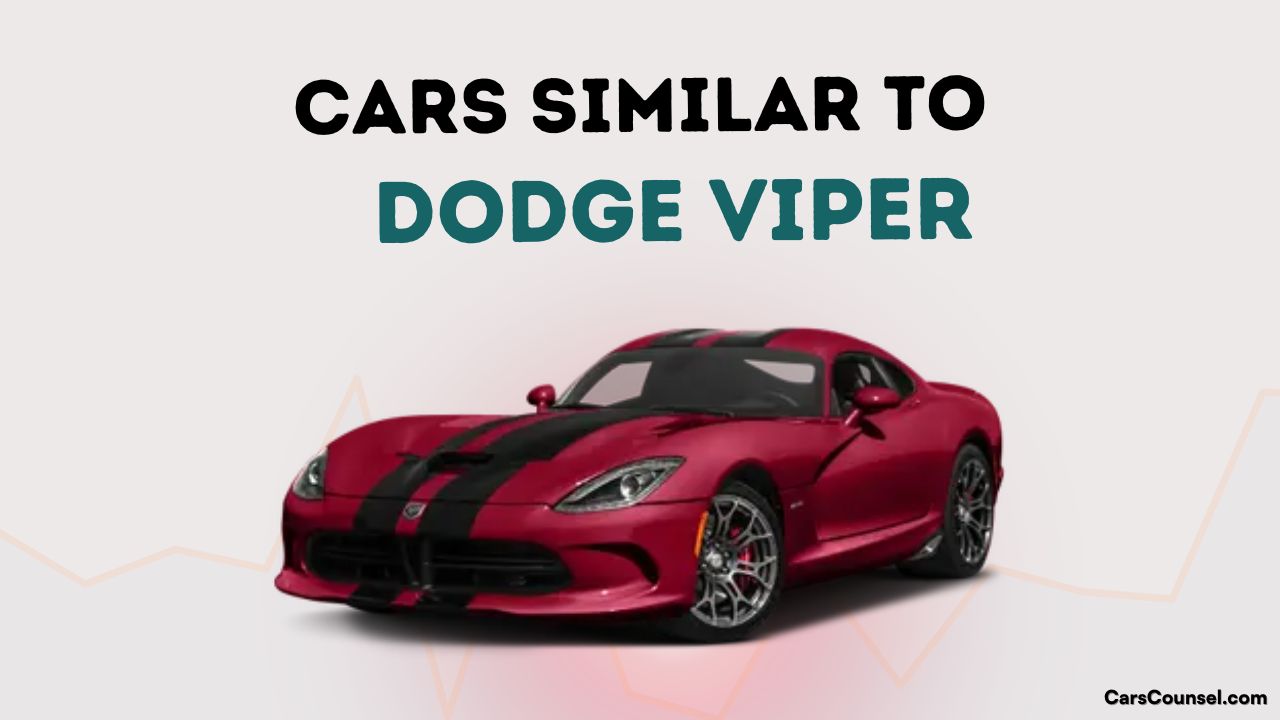When you’re in the market for a high-performance ride, you’re likely considering the Viper’s impressive stats – but what if you want something similar, yet distinct? You’re not alone. Luckily, there are alternatives that’ll give you the adrenaline rush you crave. From the 90s Corvette ZR-1 to the Ford Mustang Shelby GT500, these cars pack a similar punch without the exact same badge. Let’s delve into these options and see which one gets your heart racing.

Quick Navigation
Key Takeaways
- The 1990s Corvette ZR-1 boasts 380 horsepower, rivaling the Viper’s performance at a lower price tag of $58,995.
- The VLF Force One offers a premium alternative with 745hp, rivalling the Viper’s performance at $286,500.
- The Bristol Fighter uses the Viper’s 8.0-liter V10 engine, producing 525 horsepower, with a limited production of fewer than 15 units.
- The Devon GTX features a modified 8.4-liter V10, churning out 650 horsepower, taking inspiration from the Dodge Viper.
- The Ford Mustang Shelby GT500 has a 5.8L turbocharged V8 engine, producing 662 hp, rivaling the Viper’s performance.
Dodge Viper Alternatives
If you’re in the market for a car similar to the Dodge Viper, you’re in luck.
There are several alternatives that offer comparable performance at varying price points.
The 90s Corvette ZR-1, for instance, boasts 380 horsepower, rivaling the Viper’s performance at a lower price tag of $58,995.
If you’re willing to spend more, the VLF Force One, with its 745hp V10 engine, offers a more premium alternative for $286,500.
These options provide a range of choices for those seeking a high-performance ride similar to the Dodge Viper.
The Ford Mustang Shelby GT500
The Ford Mustang Shelby GT500 is a high-performance variant of the iconic Mustang, boasting a 5.8-liter turbocharged engine that cranks out 662 horsepower and 631 lb-ft of torque, making it a formidable rival to the Dodge Viper’s performance capabilities. You’ll appreciate its exceptional acceleration, going from 0-60 mph in just 3.5 seconds and reaching a top speed of over 200 mph.
| Feature | Specification |
|---|---|
| Engine | 5.8L turbocharged V8 |
| Horsepower | 662 hp |
| Torque | 631 lb-ft |
| 0-60 mph | 3.5 seconds |
| Top Speed | Over 200 mph |
The 90s Corvette ZR-1
You’ll find the 1990s ZR-1 Corvette’s hand-built, all-aluminum 5.7-liter V8 engine to be a powerhouse, boasting 380 horsepower.
This engine, built with precision, is what sets the ZR-1 apart as a competitor to the Dodge Viper.
With its impressive power output, the ZR-1 is sure to deliver exceptional performance.
Hand-Built Powerhouse
This hand-built powerhouse packed a punch, boasting a 5.7-liter V8 engine that cranked out 380 horsepower, making it a force to be reckoned with on the road.
As a high-performance engine, it featured four-bolt main bearings, a forged steel crankshaft, and titanium connecting rods.
You’ll appreciate the advanced six-speed manual transmission and 3.45:1 rear axle ratio, which contributed to its impressive acceleration and speed.
With its hand-built design, the ZR-1 was a more affordable option compared to the Viper, priced at $58,995.
Aluminum V8 Engine
Packing 380 horsepower, the Corvette ZR-1’s hand-built, all-aluminum V8 engine was an impressive upgrade from its predecessors. You’ll appreciate the engine’s exceptional performance, thanks to adjustable Delco/Bilstein gas-filled shock absorbers. With a six-speed manual transmission, you’ll enjoy optimized acceleration and handling.
| Performance | Specifications |
|---|---|
| 0-60 mph | 4.5 seconds |
| Top speed | 175 mph |
| Engine type | 5.7-liter V8 (not V10 engine) |
| Transmission | Six-speed manual |
The Corvette ZR-1’s engine was a game-changer in 1990, offering a significant boost in power and performance capabilities.
Buying a Used Dodge Viper
When considering a used Viper, you’ll need to balance the car’s pricing and value with the unique ownership experience it offers.
Early Viper models, for instance, can be a more affordable way to own a piece of American automotive history.
As you weigh your options, keep in mind that owning a high-performance vehicle like the Viper comes with specific maintenance costs and requirements.
Viper Pricing and Value
You’re considering buying a used Viper, and naturally, you want to know what it’ll cost.
The Viper’s pricing varies depending on the generation, trim level, and condition:
- Base Model (1992-2002): Expect to pay between $20,000 and $40,000.
- GTS (1996-2002): Prices range from $30,000 to $60,000.
- SRT-10 (2003-2006): You’ll find prices between $50,000 and $80,000.
- Gen 5 (2013-2017): The latest Viper models cost between $80,000 to $120,000 in mind.
Remember to research and compare prices to certify you’re getting a fair Viper pricing for your money, and to guarantee you’re making a well-informed purchase.
Early Viper Models
With a better understanding of Viper pricing, it’s time to explore into the early models that started it all.
The original Dodge Viper boasted an 8.0-liter V10 engine and 400 horsepower, making it a raw, unfiltered driving experience.
Early 90s Vipers command good money, like a 1993 Dodge Viper with 19,000 miles selling for $37,000 in 2024.
As a niche product with only 32,000 units sold, finding a used Dodge Viper is rare and desirable.
Remember to thoroughly check any used car to certify you know what you’re buying.
Viper Ownership Experience
Buying a used Dodge Viper requires careful consideration, as these high-performance vehicles can be significant investments.
You’ll need to weigh the cost of ownership against the thrill of driving a performance car with a rich history.
- Budget: Be prepared to spend upwards of $37,000 for an early model or over $250,000 for a 2017 Viper ACR.
- History: Research the car’s past to verify it’s in good condition and free of underlying issues.
- Condition: Inspect the vehicle thoroughly to avoid costly surprises down the road.
- Desirability: Bear in mind that the Viper’s popularity and iconic status can drive up demand and prices.
Cars Based on the Dodge Viper Platform
Several high-performance cars have been built using the Dodge Viper’s platform, and these vehicles boast impressive specifications.
You’ll find the Viper’s 8.0-liter V10 engine in the Bristol Fighter, producing 525 horsepower. The Devon GTX features a modified 8.4-liter V10, churning out 650 horsepower. The VLF Force 1 takes it up a notch, with a modified 8.4L V10 producing 745 horsepower.
Even the Chrysler Firepower concept used the Viper’s suspension and platform, paired with a 6.1L V8. These cars showcase the versatility of the Dodge Viper platform, offering unique high-performance experiences.
The Alfa Romeo TZ3 Zagato Stradale
The Alfa Romeo TZ3 Zagato Stradale is a rare, high-performance car that turns heads with its unique design styled by Zagato.
You’ll be impressed by its liter V10 engine, from the fourth-generation Dodge Viper SRT-10.
- Only nine units of the Alfa Romeo TZ3 Zagato Stradale were produced.
- The price tag of $700,000 makes it a luxury for car enthusiasts.
- The TZ3 Zagato Stradale features a hand-built all-aluminum 5.7-liter V8 engine, similar to the Corvette ZR-1.
- It was revealed at the 2010 Concorso d’Eleganza Villa d’Este in Italy, and subsequently, it debuted to the public.
The Devon GTX
You’re likely familiar with the Alfa Romeo TZ3 Zagato Stradale’s unique design and impressive performance specs. The Devon GTX, on the other hand, takes inspiration from the Dodge Viper:
| Feature | Specification | Note |
|---|---|---|
| Engine | 8.4-liter V-10 | Mildly modified from Viper |
| Horsepower | 650 | – |
| Production | 2 (out of 36) | Serial numbers 1 and 2) |
| Design | Retro elements | Heavily altered body |
| Price | $500,000 | Top-spec |
The Devon GTX’s design is unmistakably Viper, particularly the entire roofline, which is borrowed from the Dodge Viper.
The VLF Force One
Henrik Fisker’s design genius shines bright in the VLF Force One, which burst onto the scene at the 2016 Detroit Auto Show.
This American supercar boasts a 745hp V10 engine borrowed from the fifth-gen Viper and modified to produce more power.
Here’s what sets it apart:
- Unique motor mounting: The car’s motor mounting points are pushed as far away from the front axle as possible, allowing for better weight distribution.
- Lightweight body: The entire body is made of carbon fiber, keeping the weight down and performance up.
- Exclusive production: Only five examples of the Force One were ever built, making it an ultra-rare find.
5. Impressive power-to-weight ratio: With 745hp and a lightweight body, the VLF Force One is a force to be reckoned with, rivaling the Dodge Viper in terms of performance.
The Bristol Fighter
If the VLF Force One’s exclusivity piqued your interest, you’ll be intrigued by the Bristol Fighter, a limited-production supercar that shares some DNA with the Dodge Viper.
This British-American collaboration features a coupe design powered by a big frontally-mounted Chrysler engine.
With gullwing doors, the Bristol Fighter produces 525 horsepower and 525 pound-feet from its 8.0-liter V-10 unit.
It sprints to 60 mph in around 4 seconds, with a top speed of 210 mph.
Hand-built, each unit is unique, with fewer than 15 produced, including the 600-plus horsepower Fighter S.
When exploring alternatives, make sure to checkout other similar models like Dodge Dart, Dodge Magnum, Dodge Omni, and Dodge Hornet. Comparing these vehicles side by side helps you see where each stands out in terms of price, performance, features, and reliability. Our in-depth breakdowns highlight which alternatives make the best fit for different drivers. By reviewing these, you’ll discover which competitors best match your driving needs and lifestyle.
Conclusion
As you navigate the high-performance landscape, consider the Dodge Viper alternatives that rev up the competition. Like a masterfully crafted puzzle, each contender fits in tandem with its own unique strengths, from the Ford Mustang Shelby GT500’s brute force to the VLF Force One’s sleek sophistication. With a range of options to choose from, finding the perfect fit is akin to finding the missing piece that completes the picture – a harmonious blend of power, style, and performance.

